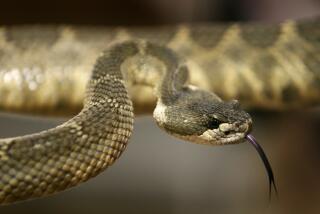Toddler Recovering After Encounter With Rattlesnake
- Share via
SIMI VALLEY — It was early Sunday evening, the end of a long holiday weekend at the McKee house on Hempstead Street.
Eleven-month-old Hannah McKee played in the backyard, bouncing up and down in her walker, just a few feet from cattle-grazing land separated from the home by a flood-control channel.
For the record:
12:00 a.m. July 17, 1997 For the Record
Los Angeles Times Thursday July 17, 1997 Ventura County Edition Metro Part B Page 7 No Desk 2 inches; 42 words Type of Material: Correction
Rattlesnake bite--An article Friday about an 11-month-old girl treated at Northridge Hospital Medical Center for a snakebite contained inaccurate information. She was first treated at Simi Valley Hospital, then taken to Northridge by a team of health-care workers from the Northridge facility.
Suddenly, she began to cry.
Her parents, Kathryn, 30, and Charles, 38, noticed a trickle of blood on her foot and called the emergency room at Simi Valley Hospital. Soon, the leg began to swell. They decided to take her in for treatment.
A doctor told them that Hannah was probably bitten by a snake and that she required intensive care. Simi Valley Hospital is not equipped with a pediatric intensive care unit, so the McKees drove Hannah to Northridge Hospital Medical Center.
Doctors there lanced her leg to relieve the swelling, and she was treated with snake antivenin, authorities said.
Hannah remained at Northridge hospital Thursday. It will probably be a few days before she can go home with her family, including 2-year-old sister Rebecca.
“She still feels pretty bad but she looks happy and healthy,” said a relieved but harried Kathryn McKee. “She’s doing much better now.”
The phone at the McKee house has not stopped ringing since Sunday.
“We’ve been getting so many phone calls from family members and from friends, and all we want to do now is spend time with our daughter,” Kathryn said.
“That’s what we’re doing now, spending time with her at the hospital.”
Word of the snakebite caught some people by surprise in the neighborhood, located on the north edge of the city, east of Tapo Canyon Road.
“We saw a few when we first moved here 32 years ago, but I haven’t seen any others down on this street since then,” said one resident.
Others said it’s only natural that in this area--where housing developments abut rolling hills--that man and snake would meet.
“When you live in God’s country, near the hills, you take the chance of seeing a snake,” said 19-year-old Adam Valdez of Simi Valley.
Nora Demirjian, 13, of Canoga Park, said the recent bite would not discourage her from taking her friend’s daughter, 1-year-old Natalie Dernersesian, out for a walk on Hempstead.
“Snakes are probably a problem in the hills,” Nora said, “but it probably isn’t a problem down here.”
Hempstead Street, one of the main roads to Big Springs Elementary School, is used by many children in the neighborhood. Don DaCosta, an equipment operator for the Simi Valley Unified School District, said he has never heard of a rattlesnake in the neighborhood--and he has lived in Simi Valley for 20 years.
“My friends and I used to go up in the hills all the time and shoot at snakes,” said DaCosta, 30. “We’ve killed a few rattlesnakes, one big one and a couple of smaller ones.”
According to the national Centers for Disease Control and Prevention in Atlanta, an estimated 45,000 snakebites occur in the United States each year. Of those, 7,000 are from venomous snakes.
About 12 people die each year from venomous snakebites, according to the CDC.
Although nobody saw the snake, health care officials said Hannah’s reaction to the venom proves that she was bitten by a rattlesnake, probably a southern Pacific rattler because those are the most common in this area. They also believe it was a juvenile, based on the space between the puncture wounds, said Patrick Musone, community education officer for the Ventura County Animal Regulation Department.
Musone said a common misconception is that a bite from a juvenile snake is more dangerous than that of a mature snake, because the juveniles don’t meter their venom. That is, when the snake bites, the venom just keeps flowing.
“They don’t meter their venom, but they don’t have as much venom as the older snakes,” Musone said. “They’re both bad.”
Of the venomous snakes in the U.S., the southern Pacific rattler is the least aggressive, according to Musone.
“You have to step on them, sit on them, do something like that to be bitten,” according to Musone. And that, he said, is likely what happened in Hannah’s case--she probably did something to disturb the snake and cause it to strike.
*
The key to keeping snakes away from your home is to keep the home free of the things that attract snakes--rodents.
Musone recommends trimming bushes and trees to about 2 feet off the ground, keeping exterior doors and windows closed at all times and installing rubber or wooden gaskets under all exterior doors, including the garage door.
Remove old piles of wood, trash and junk--they make ideal hiding places for reptiles and rodents, he said.
People bitten by snakes should be taken to a medical facility immediately, says the American Red Cross. The wound may be washed, but Red Cross guidelines discourage using ice, cutting a snakebite or using a tourniquet.
Now that their daughter is stable and doing well, Kathryn McKee said she and her husband want to make sure no other families experience the pain their daughter’s snakebite has caused them.
“We want to educate people about snakebites so it won’t happen to them,” she said.
More to Read
Sign up for Essential California
The most important California stories and recommendations in your inbox every morning.
You may occasionally receive promotional content from the Los Angeles Times.













